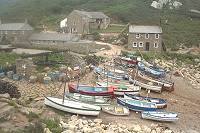Tourism in Penzance & West Cornwall
The Far West
West of Penzance, and encompassing the Lands End peninsula itself, is an area frequently called "The Far West". It is a countryside and coastal region with myriad isolated coves, beaches and inland villages set amongst dramatic cliffs and wild moorland reminiscent of times gone by. These peaceful places are all, nevertheless, easily reached by today's visitor and each gives a glimpse into Cornwall's past way of life.
Lamorna, Penberth & Treen
After leaving Mousehole and the immediate surroundings of the resort town of Penzance, the roads become narrow and winding. First on the route around the coast is the wooded valley of Lamorna, leading down to the small breakwater and beach of Lamorna Cove, popular with divers exploring the rocks just offshore.

Beyond here, after passing the home of the late Derek and Jeannie Tangye, the road passes down and up again a very steep hill, at the top of which is a narrow lane to the secluded Penberth Cove where, from the granite slipway, fishing boats continue to operate daily. A great wooden capstan at the head of the slipway was once used by the fisherman to recover their boats.
The next turning takes the visitor into the hamlet of Treen, with an attractive little pub while a footpath beyond leads out to Treen Cliff. On the tip of Treryn Dinas or Treen Headland is the "rocking" Logan Rock which ,in 1824, a naval lieutenant - in a fit of bravado - rocked so vigorously that it ended up in the sea. He was then required to put it back - no small task since the rock weighs nearly 100 tons!

Porthcurno
Porthcurno is located some 7 miles south-west of Penzance and is set in a narrow valley leading to one of the finest beaches in Cornwall. Here the golden sand is set in a cove beneath a curve of granite cliff where, facing to the south-east, it acts as a sun-trap to the joy of sunbathers, while the sea is a magnificent turquoise-blue (reminiscent of Caribbean beaches). Above the western end of the beach is the famous Minack Open-Air Theatre and beyond stretches the coastal footpath leading past Porth Chapel and Porthgwarra and thence on towards Lands End
Porth Chapel & Porthgwarra
Passing beyond Porthcurno and the Minack Theatre, a small road continues to the hamlet of St Levan where the road ends and a footpath leads down to the cliff-backed Porth Chapel cove. Seals are often seen close to the beach at this idyllic spot.
A mile or so beyond the Porthcurno turning on the coast road will be found the way down to Porthgwarra - a very narrow partly sandy cove with a fascinating archway through the cliff as an entrance. Above here lies Gwennap Head where the coastal path continues over wild moorland cliff-tops towards Lands End.
Sennen
Sennen village, where one of the most notable buildings is the First & Last Inn, lies directly on the main road just before reaching Lands End itself. Turning from the main road just before the village, a road leads steeply down to the magnificent open vista of the dune-backed sands of Sennen Cove and its neighbour Gwenver Beach. This wide beach is one of the most popular amongst the Penzance area beaches and is highly recommended for surfing. The Lands End lifeboat is based at the end of the beach alongside a granite slipway where, again, fishermen regularly put to sea.
St. Just
St Just (or St Just-in-Penwith to give it its full name) is the most westerly town in England and was famed as the centre of the West Cornwall mining industry. Scattered around the outside of the town are numerous signs of the long-vanished mines and its granite character reminds the visitor of the solid and lasting background to this small remote town.
From the centre of the town, a road leads to Cape Cornwall - the only Cape in the west of England. From the Cape, magnificent views can be had both up and down the coast over the imposing granite cliffs.

Botallack
On the way northward from St Just, the first village to be reached in Botallack - again an important mining village in the "heyday" of Cornish mining. On the cliffs below the village is the famous Crowns Mine, where the engine houses still stand today appearing to be clinging onto the side of the cliffs precariously balanced over the sea.
Much of the television series "Poldark" was filmed in this area and those who remember the series will recognise many of the locations.
Trewellard & Pendeen
The two villages of Trewellard & Pendeen are set one each side of the famous Geevor & Levant Mines where the restored steam engine of Levant and the Mining Museum at Geevor are both well worth a visit to learn more of the mining and industrial history of this part of the Lands End peninsula. Today there is an interesting pottery which welcomes visitors and a small jewellery maker's shop.

Zennor
Midway between St Just and St Ives lies the small hamlet of Zennor. The view of the hamlet while approaching down the winding coast road is a true "picture postcard", with the attractive church alongside the small pub forming the centrepiece.
The Zennor Wayside Museum is just a few steps away from the Tinners Arms pub, while a footpath starting between the church and the pub leads down to Zennor Cove. Here the legendary Mermaid of Zennor is said to have lured one of the village young men into the sea to spend his remaining days with her. This is commemorated on a small plaque in the church.

